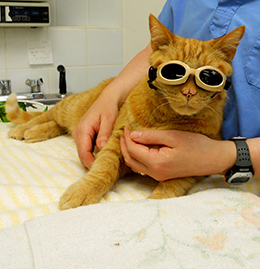My series of blogs about our family of Amherst Pets would not be complete if I did not introduce you to at least one of our feline family members. Admittedly, we get to see the dogs of Amherst much more often then we see the cats. Not because our dogs get into more trouble and need more veterinary care but because they are much more likely to come to work with us, just to spend the day. My own dog Sadie for instance is quite happy to come to work with me. She spends the day quietly sleeping under my desk, waiting for the opportunity to stealthily steal the lunch of one of the other unsuspecting Veterinarians who has left her lunch out unattended on the desk. Our cat pets, however not surprisingly, prefer to stay home so we only tend to see them when they are in need of veterinary care.
Charlie is a handsome, 11 year old, orange tabby cat that belongs to Kathie our office manager. She took over his care about 2 years ago and we have all gotten to know him quite well during this time. Charlie is often seen in the treatment area at Amherst Veterinary Hospital, not because he particularly enjoys spending his day watching the comings and goings of other dogs and cats, but because he repeatedly gets himself into fights with the neighbour’s cats and ends up with an abscess that needs veterinary attention.
Sweet, docile Charlie is the persona he presents to us at Amherst. However Kathie’s neighbour’s cats Daisy and Mister have another story. Charlie is known to purposely walk by the neighbour’s glass patio doors just to taunt the cats, sending them into a frenzy. It is believed that Mister and Charlie would duke it out whenever they were outside at the same time.
The first time Charlie was a patient at our Vancouver veterinary hospital, he had a large, fluctuant, painful swelling on the side of his body and a low grade fever. At home he had been acting odd, slinking around and hiding. A few days earlier Kathie had heard a scuffle outside. Charlie had come home a bit ruffled but he seemed fine otherwise. It was not until 3 days later that the swelling was noticed on his body.
This is a very typical history we hear in regards to abscesses on cats. What happens is a cat gets into a fight with another cat and is bitten. There is a small puncture made through the skin that goes unnoticed because a cat is covered in fur. However a cat’s mouth is full of bacteria, which via the bite, is inoculated under the skin and often into the muscle of the ‘victim’ cat. The bacteria multiply in the closed space and a few days later you have a pus filled abscess.

Draining the pus filled abscess

At this stage the abscess has to be drained and cleaned. This is often done with the cat sedated or under a general anesthesia. The wound is opened and cleaned and if it is a large or deep wound, a drain will be placed into the abscess site for a few days to allow any new pus to continue draining.
Lastly the cat is placed on antibiotics and pain medication. For antibiotics there is the option of pills or liquid that is given by mouth twice a day for typically 2 weeks. In recent years a new long acting injectable antibiotic, Convenia has been licensed for cats that is very effective for abscesses. The antibiotic remains effective for 2 weeks after 1 injection. This is a very popular antibiotic option as not surprisingly many cat owners when given the choice will choose an injection given to their cat at the hospital versus pinning their cat down twice a day to give them medication at home. This antibiotic has saved many a cat/owner relationship.
Recently we have started using cold laser therapy as part of the treatment for cat abscesses. We find that it decreases swelling and pain in the affected area resulting in faster healing.
After a couple of visits to Amherst with Charlie, Kathie began to recognize the telltale signs of a recent bite wound: A part of Charlie’s fur would seem a bit out of place, he’d be tender in that area and she could feel a little scab on the skin. In these early stages, we could just clip Charlie’s fur around the scab, clean and flush the bite wound and give him an antibiotic. Because the bite wound had not developed into a painful abscess yet, Charlie would allow us to treat him without sedation. If a bite wound is noted and treated early like this, the development of an abscess can be prevented, saving discomfort for the cat and cost to the owner.
Recently, Mister, Charlie’s nemesis passed away. Since his passing Kathie has not found many scratches or wounds on Charlie either. We are sad for the loss of Mister but are glad that Charlie’s fighting ways are more limited these days.


